Mushrooms have long been a staple of various cuisines around the world, but did you know that Florida is home to a diverse array of mushroom species?
From edible varieties used in gourmet dishes to inedible ones that come in stunning colors, mushrooms are found all over the state. The humid and warm climate of Florida provides an ideal environment for these fungi to thrive, making it a hot spot for mushroom enthusiasts.
What are common mushrooms in Florida? In this state you will find red mushrooms such as cinnabar chanterelles, white puffballs mushrooms, lion’s mane, honey mushrooms and more.
Below, we discuss common and rare mushrooms of Florida.
List of Mushrooms in Florida
1. White Chicken Mushroom (Laetiporus persicinus)
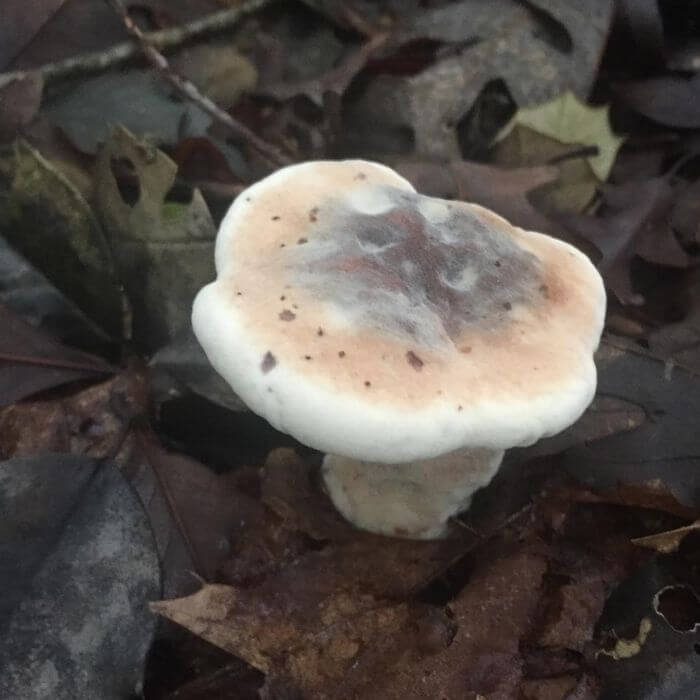
source: d_dubbed
Closely related to chicken of the woods, the white chicken mushroom is a common edible mushroom of Florida that belongs to the family Fomitopsidaceae.
It also gets its name due to its distinct appearance and taste. The fungus typically grows on living or dying softwood and hardwood trees during spring and fall.
Like its cousin, the fruiting body of the white chicken mushroom has a shelf-like structure with multiple layers that range from salmon pink to brown in color.
Its pores are small and round compared to other chicken-of-the-woods mushrooms, which have larger pores that are more elongated.
You can use this edible mushroom as a meat substitute.
2. Chanterelles
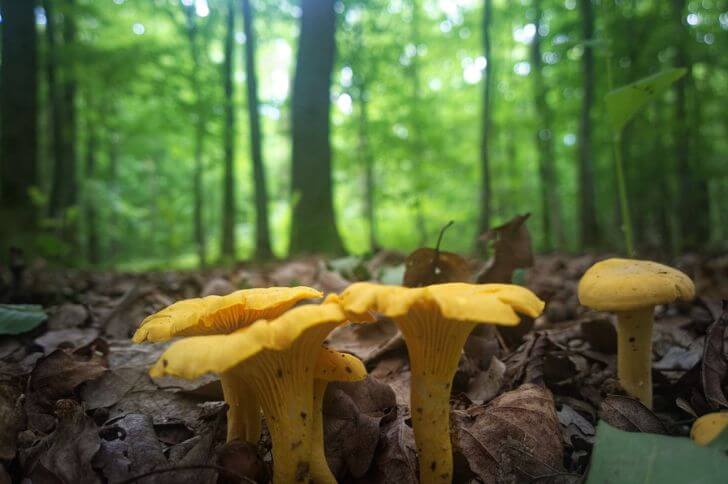
Common chanterelles in varieties include:
Cantharellus coccolobae: Common in the tropical regions this chanterelle is known for its distinctive pink-orange color and trumpet-shaped cap with a depressed center.
You can find them between August and September, growing alone or in groups around sea grapes. They are related to the red chanterelles below.
Cantharellus cinnabarinus: Red chanterelles belong to the family cantharellaceae and are highly prized for its unique flavor profile.
The cap of this chanterelle ranges from bright red-orange to flamingo pink and has a shallow, depressed center. The flesh of the mushroom is firm and has a fruity aroma that becomes more intense when cooked.
Fragrant chanterelles: This variety typically grows around oaks. Fruiting body consists of several bright yellow mushrooms with vase-like bodies.
Cantharellus tenuithrix: This variety prefers hardwood forests across Florida. Cap is egg yolk yellow with whitish ridges underneath.
Cantharellus lateritius: With its wavy edges and smooth cap, the smooth chanterelle is another variety of yellow mushroom in Florida. Check for it around hickories and oaks. Smooth chanterelles have a sweet, apricot odor.
Cantharellus minor: Popping out in late spring to fall, the cantharellus minor also grows around oaks. Its fruiting body is thinner than most chanterelles and it grows to about 1.6 inches tall. On the underside, it has irregularly shaped ridges rather than true gills underneath, which are forked or blunt at the ends.
Cantharellus quercophilus: Commonly found under oaks in sandy soils, this chanterelle is another edible fungus of Florida. They are yellowish-brown.
3. Morels
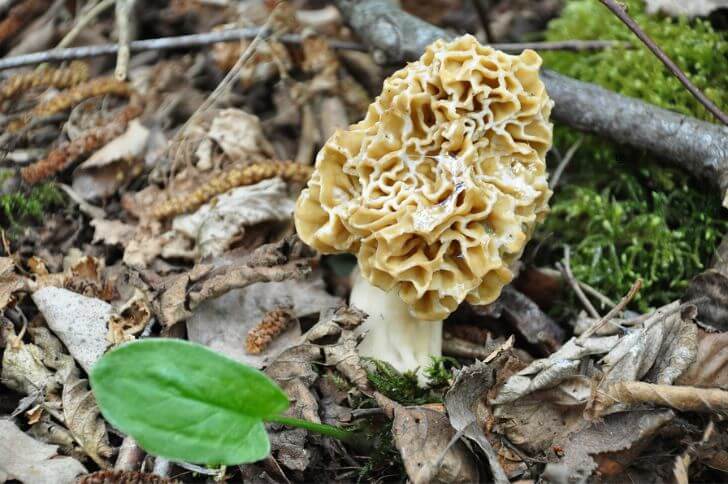
Are there morels in Florida? Morels are one of the rarest mushrooms in FL. The only noted occurrence was near the Georgia border. And even then, it was a small number.
If you live along the border, you can find them from late February.
Why are morels rare in Florida? Because the state’s soil isn’t conducive for the growth of morels.
If you want to enjoy these mushrooms, check online stores for dried options.
4. Honey Mushrooms
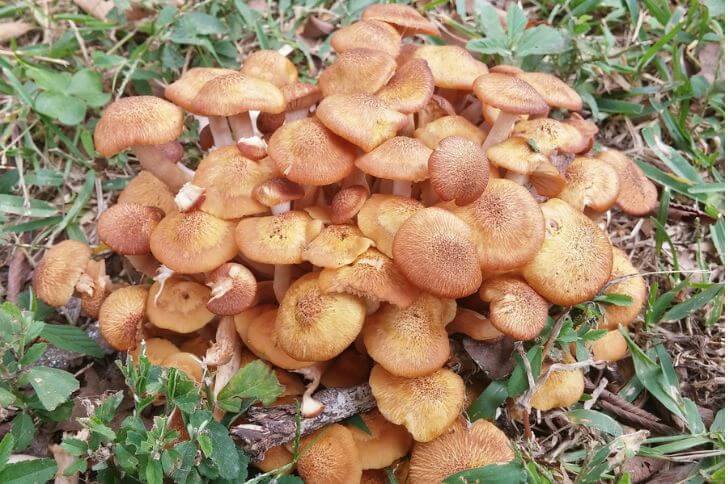
Ringless honey mushrooms are one of the most common mushrooms in Florida. Occuring in in late fall through early winter, they are found all over the state.
This species is known for forming large underground networks called rhizomorphs, which can spread over great distances and infect multiple trees. In fact, desarmillaria caespitosa is considered one of the most destructive forest pathogens.
Honeys can infect a variety of tree species including oak, pine, cypress, and hickory.
One way to honeys by examining their cap. The cap of desarmillaria caespitosa typically ranges from 1-4 inches in diameter and is convex when young but flattens out with age. The color can vary from light brown to dark reddish-brown and may have tiny scales or fibers covering its surface.
Honeys occur in tight clusters and this variety does not have a ring on stem like its cousins. Also, for proper identification, check its spore print. These brown mushrooms have a white spore print.
5. Shiitake (Lentinula edodes)
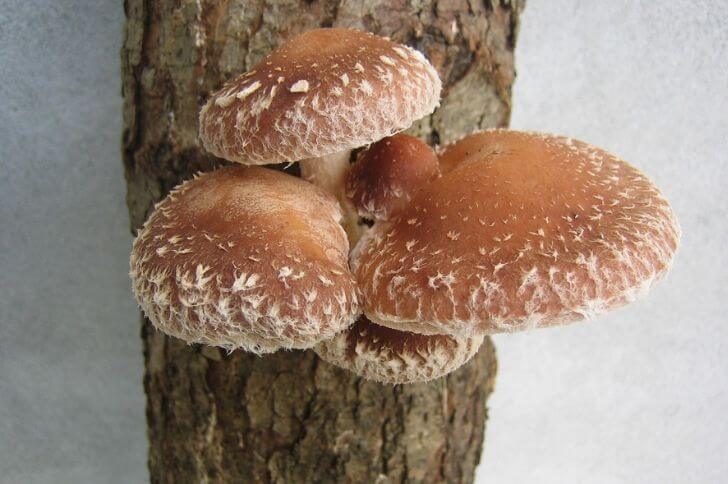
Lentinula edodes, commonly known as shiitake, is a popular edible mushroom that is widely cultivated and consumed in FL. It is distinguished by its meaty texture and rich umami flavor, making it a favorite amongst foragers and food enthusiasts alike.
One of the most notable features of this shiitake mushroom is its cap shape and color. The cap is typically umbrella-shaped with an average diameter of 2-6 inches.
The color ranges from dark brown to tan depending on the age of the mushroom. This brown Florida mushroom fruits in spring to autumn. Check around maples, beech, oaks and poplars.
These brown mushrooms are also cultivated and are tastier than their white counterparts.
6. Indigo Milk Caps
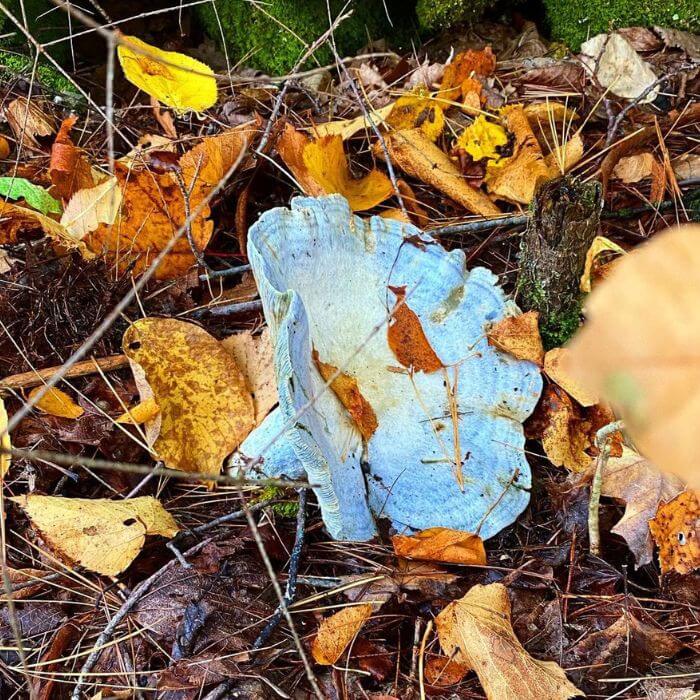
source: bogs.n.logs
Indigo milk caps are edible blue foods that are relatively widespread in the Sunshine State.
Also called lactarius indigo or blue milk mushroom, these Florida mushrooms are easy to identify due to their color and the milky latex they produce when they are damaged. Their bright blue coloration turns to green when bruised or cap.
Caps can grow to 5.9 inches in diameter. They are also broadly convex with a slightly depressed center.
When foraging for indigo milk caps, check in coniferous forests. They need minimal cleaning but thorough cooking before consumption. They stain green when cooked.
7. Puffballs
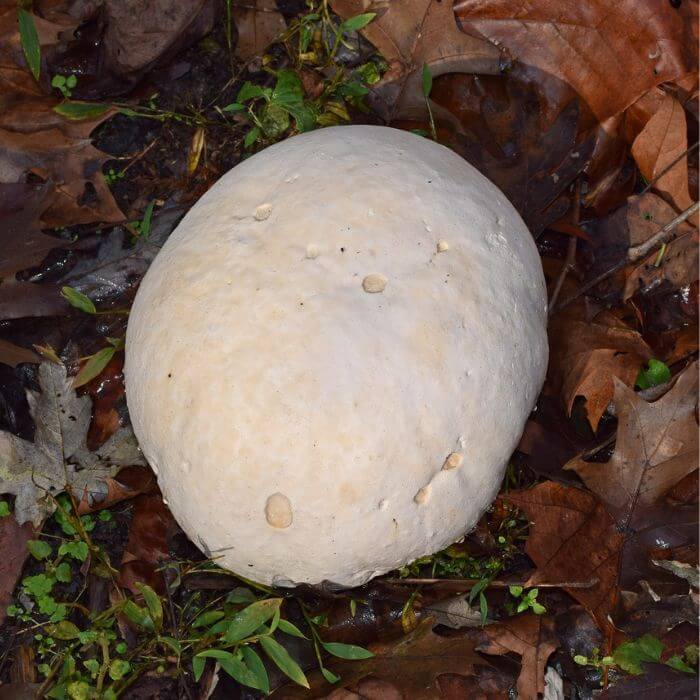
Puffballs are one of the most noticeable white mushrooms in Florida. In FL, several species of puffballs can be found throughout the year.
One common species is the gem-studded puffball (Lycoperdon perlatum), which has a white exterior covered in small bumps that turn brown as it matures. When ripe, it releases clouds of dark spores when stepped on or disturbed.
Another species found in Florida is the peeling puffball which has a small pear-shaped body. Its surface is also covered with short spines.
Other varieties include:
- Common puffballs
- Calvatia pyriformis
- Orange-staining puffball
8. Oyster Mushroom
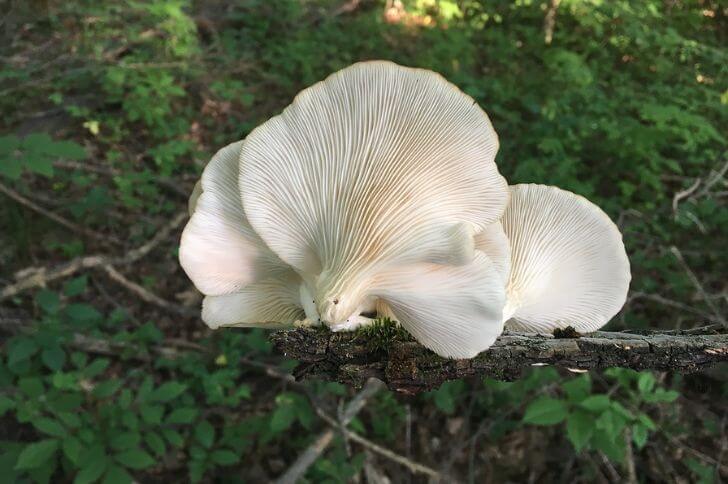
Pleurotus ostreatus, common name oyster mushroom, is a popular edible mushroom species that can be found in various parts of Florida. This fungus is named after its oyster-shaped cap and is recognized for its rich flavor and texture, which resemble that of seafood.
In Florida’s subtropical climate, oysters can be cultivated both indoors and outdoors year-round. The cultivation process involves growing the fungus on substrate materials such as sawdust, straw or coffee grounds.
Once fully grown, the mushrooms can be harvested by hand-picking them from their substrate blocks or logs. Due to their versatility in cooking applications—stir-fries or sauteed dishes—oyster mushrooms are widely consumed in the state’s culinary scene.
9. Bear’s Head Tooth Fungus
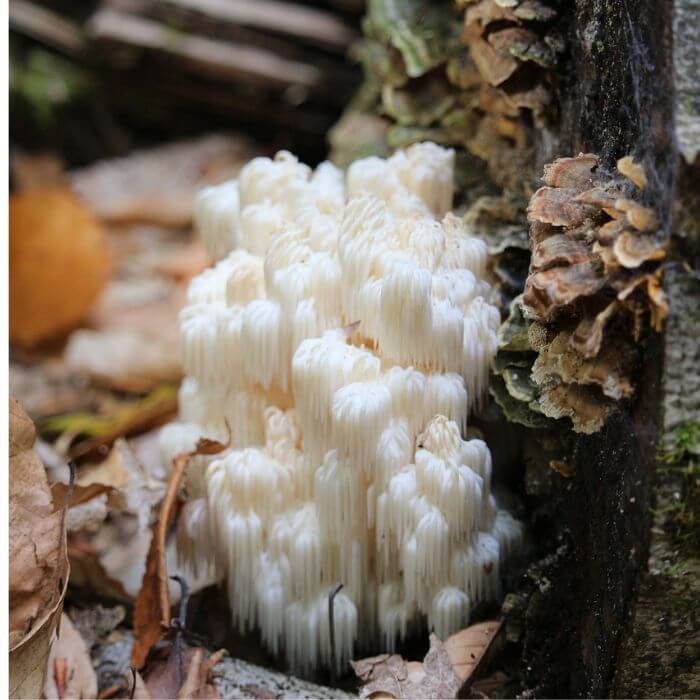
Hericium americanum, bear’s head tooth fungus, is a fascinating species of mushroom that grows on hardwood trees. It is closely related to the lion’s mane.
The bear’s head tooth fungus has a distinctive appearance with its white, shaggy fruiting body resembling a lion’s mane or bear’s head. The fruiting body can reach up to 7.8 inches in diameter and is made up of long, dangling spines.
Also, its irregular shaped body will help you tell this white mushroom apart from the lion’s mane.
When young, it is pure white but gradually becomes yellowish-brown with age. The spines are soft and fleshy when fresh but become tough and rubbery when dried out.
10. Dryad’s Saddle
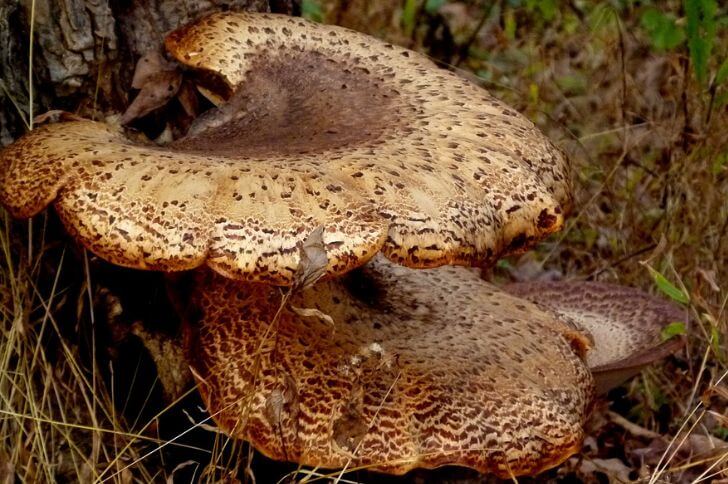
Pheasant Back mushroom, also referred to as dryad’s saddle, is a popular edible fungus that occurs in layers and grows on ash, maple, beech, elms, and box elders.
It is named after the mythological creature Dryad, which is said to have lived in trees. The mushroom has a distinct fan-shaped cap with dark brown hairy scales.
The cap of this Florida mushroom can grow up to 12 inches wide, making it one of the largest mushrooms found in FL. The texture of the cap is tough and leathery when matured, while young caps may be tender enough to eat. The underside features small pores that turn yellowish-brown with age.
11. Stubble Rosegill
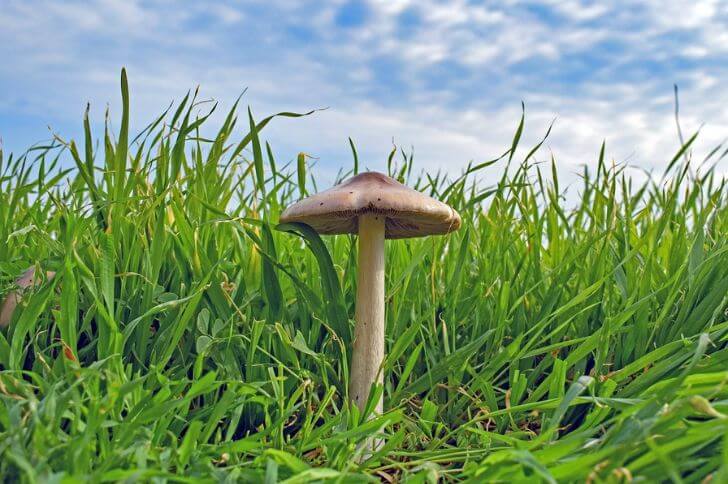
The stubble rosegill, scientifically called volvopluteus gloiocephalus, is a mushroom species that belongs to the pluteaceae family.
Common in urban settings, the stubble rosegills is an unattractive mushroom that can grow up to 6 inches in diameter.
The fruiting body is grayish when young and is convex shaped. With age, the stubble rosegill becomes broad, nearly flat and changes color to yellowish.
This gray mushroom is considered edible. However, it’s poor quality and not highly rated.
12. Bulbous Honey Fungus (Armillaria Gallica)
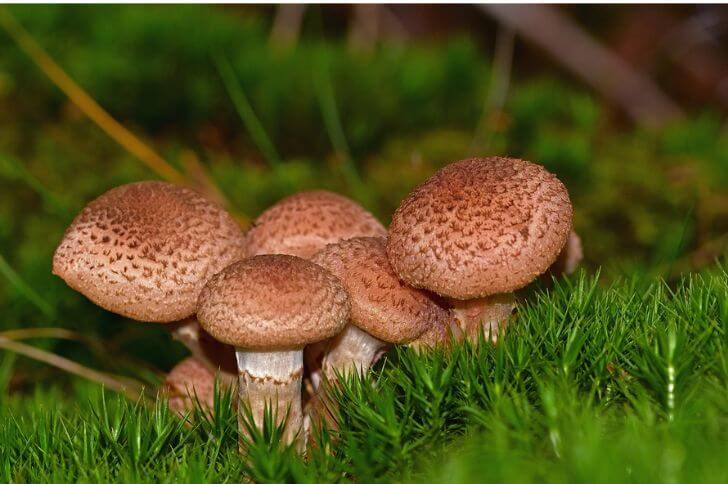
Related to the honey mushrooms above, armillaria gallica is a fungal species that is widely distributed to eastern North America.
Commonly called the bulbous fungus, these mushrooms grow gregariously. One of its notable features is its fruiting body, which typically appears as a cluster of honey-colored mushrooms with a convex cap and short, whitish gills. Note the brownish scales on the cap surface.
Another distinguishing characteristic is its rhizomorphs, which are black root-like structures that grow on or near infected trees. These structures are often seen growing along roots or tree bases.
Bulbous honey fungi are edible. Cook well.
13. Turkey Tail
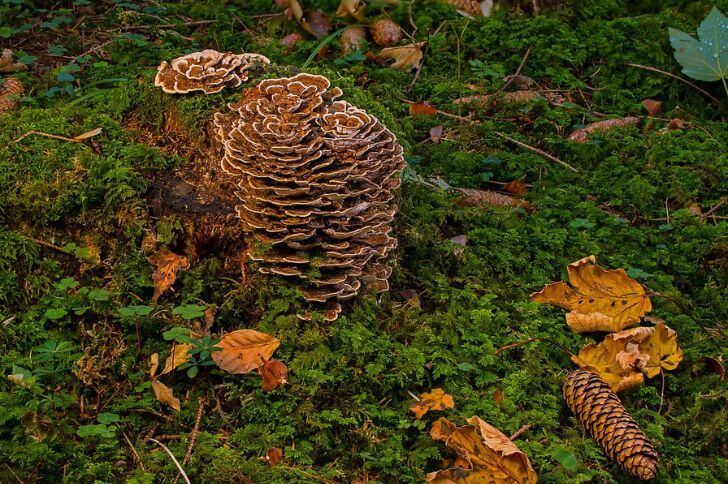
Turkey tail mushrooms are common throughout the United States including Florida. It’s been used to make teas for centuries and today mushroomers add it, in powder form, to smoothies.
How can you tell it apart from other shelf fungi? Identification can be done by examining its physical characteristics.
The cap of the mushroom is usually between 1.1 – 3.9 inches in diameter and has concentric zones with different colors ranging from buff to brownish orange.
The underside of the cap has small pores from which spores are released.
14. The Deceiver (Laccaria laccata)
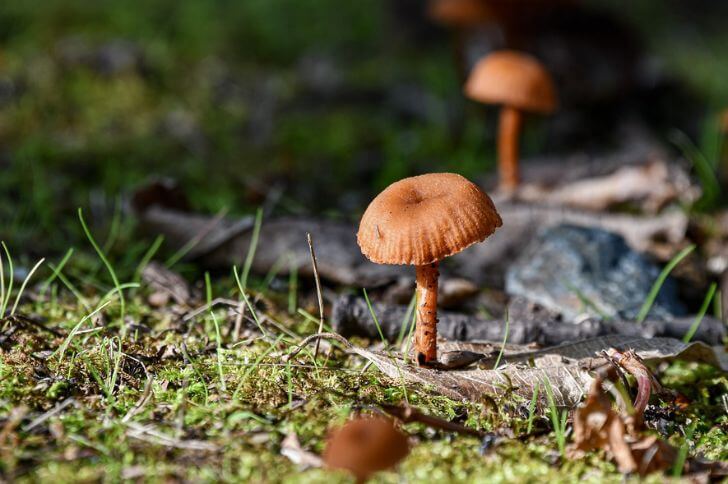
The Waxy laccaria, other name the deceiver, is a small, widely distributed mushroom in Florida. Its name, deceiver, is due to its cunning features that make identification hard.
The deceiver mushroom grows to about 2.5 inches and is initially convex. Its color ranges from brick-red to brown to salmon pink.
Laccaria laccata caps are edible and taste best when fried or in soups. However, it is not the tastiest mushroom in this list.
Inedible Mushrooms of Florida
15. Ravenel’s Stinkhorn
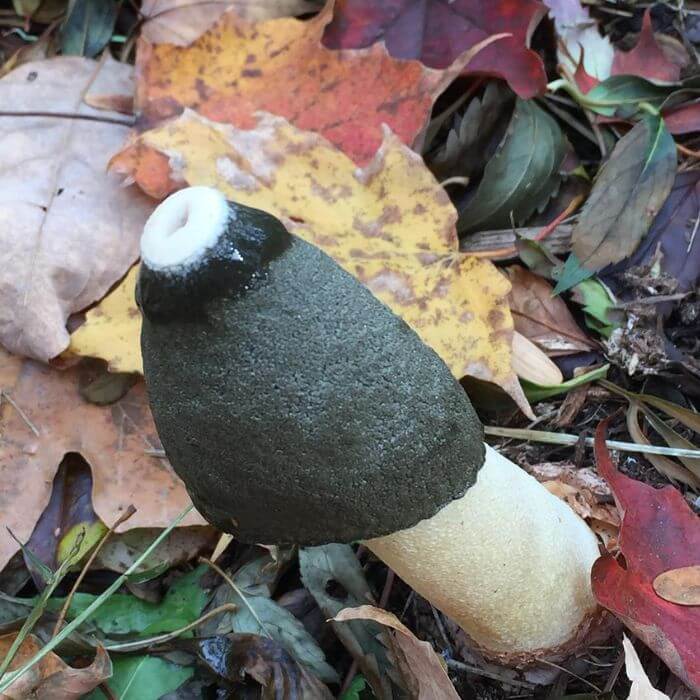
source: christophercoutant
Phallus ravenelii is a type of stinkhorn fungus that is often found in warm and humid regions like Florida. This fungus is characterized by its unique phallic shape.
It grows to be between 5-7.9 inches tall, with a stem that can range from creamy to yellowish in color.
Another distinctive feature of this Florida stinkhorn is its pungent odor. When fully matured, these fungi emit an incredibly strong smell similar to that of sewage or rotting meat. This smell serves as a lure for flies and other insects, which help spread the spores of the fungus throughout its environment.
16. Banded Mottlegill
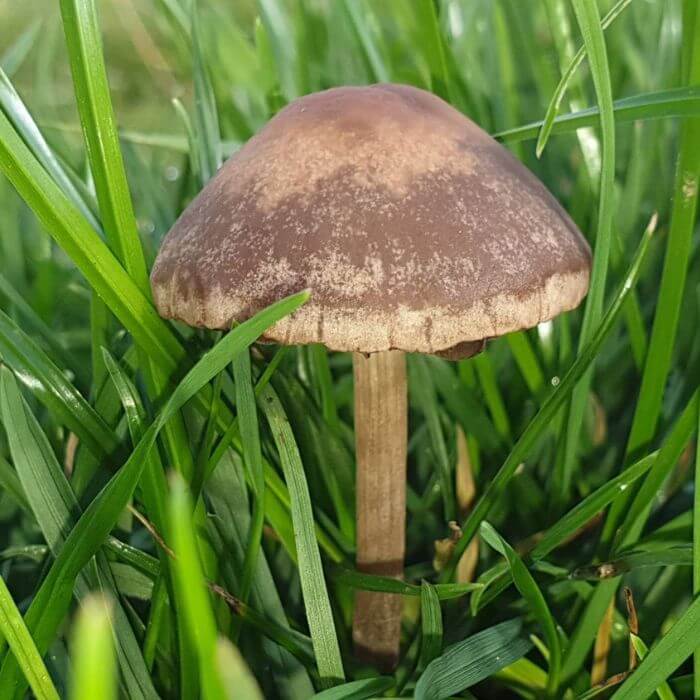
source: myskandalouzstyle
Panaeolus cinctulus is a common mushroom species from the family bolbitiaceae. Commonly called subbs or the banded mottlegill, it occurs throughout Florida.
Its cap is light brown with distinct cinnamon-light brown concentric circles, and it can grow up to 2.6 inches in diameter. The gills are brown-black, depending on age, and attached to the stem.
Banded mottlegills invade button mushrooms’ beds. Note, these brown fungi are inedible.
17. Clathrus Crispus
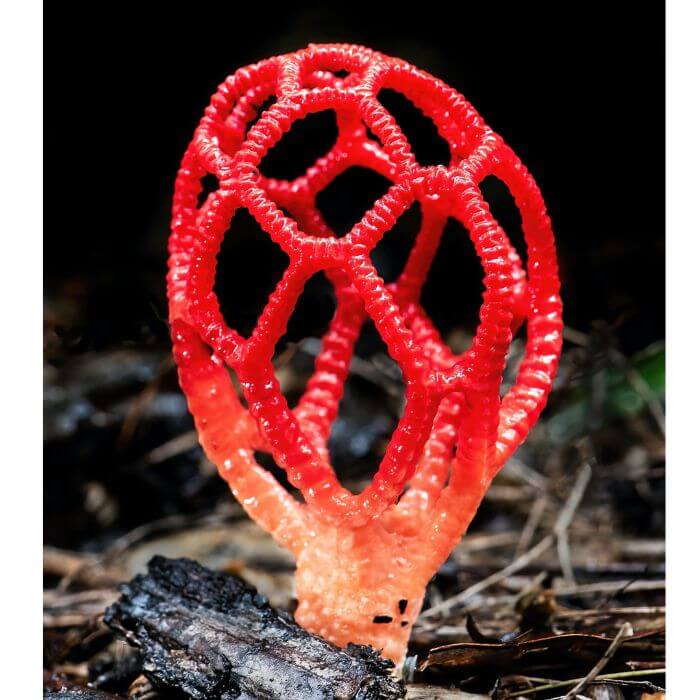
Because of its unique climate, Florida is home to some unique mushroom species like the clathrus crispus. Also, in the stinkhorn family, this mushroom stands out and is easy to identify
The clathrus crispus emerges from a white egg-like structure like other stinkhorn. This egg structure is about 2.1 inches and when it ‘breaks’ open reveals a scarlet-red mushroom with a distinctive 3.9 inch fruiting body.
Also like other stinkhorns it is covered with brown slime and produces a foul odor that attracts flies and other insects for spore dispersal.
18. Flowerpot Parasol
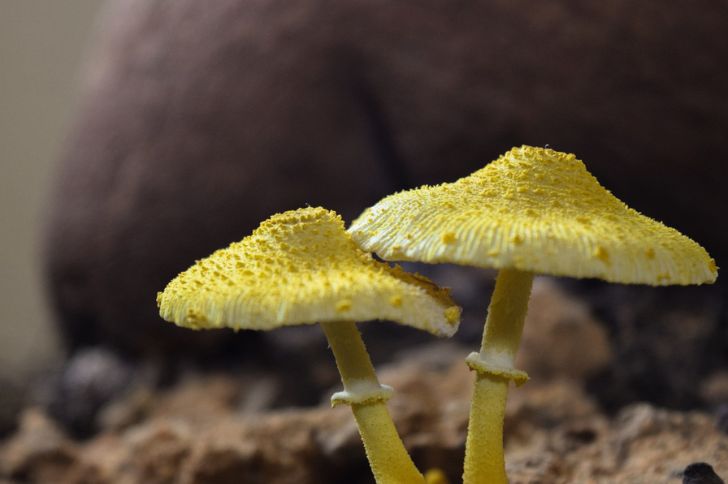
Seen some beautiful yellow fungi among your potted plants? Chances are it is a flowerpot parasol.
Scientifically called the leucocoprinus birnbaumii, this yellow fungus is commonly found in indoor potted plants.
The first thing to note is the vibrant yellow color of the cap of the mushroom. This can range from pale yellow to a deep golden hue. The cap itself is egg-shaped (young mushrooms) becoming bell-shaped or broadly convex in maturity.
Its surface is finely scaly. Underneath the short gills are yellow and not attached to the stem.
19. Cortinarius Iodes (Viscid Violet Cort)
The viscid violet cort is a particularly interesting mushroom in FL. This distinctive mushroom can be identified by its deep violet cap, which is covered in a sticky substance that gives it a shiny appearance.
As the fungus ages, yellow spots develop on the convex cap. The stem of the viscid violet cort is also an unusual color, ranging from pale lilac to purple-brown.
The viscid violet cort belongs to the family cortinariaceae. These mushrooms are often associated with trees such as oaks. Fruiting happens from July through November.
20. Clavulinopsis Laeticolor
Clavulinopsis laeticolor belongs to the family clavariaceae. It is characterized by its bright yellow color and club-shaped fruiting body, which grows up to 2 inches tall. The mushroom typically grows in summer and fall on dead wood, where it forms loose clusters.
Also, the mushroom has a smooth surface texture and lacks any distinctive aroma. Finally, when cut open, the flesh of Clavulinopsis laeticolor is white and firm.
21. Peach-colored Fly Agaric
Peach-colored fly agarics are one of the most common red mushrooms in Florida. The cap of this agaric can grow up to 5 inches in diameter and ranges from reddish to peach-colored. Its stem can reach up to 3.9 inches in height, and its gills are white.
This agaric has a white spore print. Like other fly agarics, we recommend you do not harvest peach-colored fly agarics.
FAQs
Does Florida have edible mushrooms?
One common edible mushroom in Florida is the chanterelle. These golden-hued mushrooms grow in abundance during the rainy season and can be found throughout many parts of the state. Another popular mushroom in Florida is the oyster mushroom which grows on hardwoods such as oak and maple trees. Other edible mushrooms commonly found in Florida include shiitake, morel, and chicken-of-the-woods.
What is the white fungus in Florida?
Powdery mildew is a common plant disease that affects a wide range of species including vegetables, fruits, flowers, and ornamental plants. This fungal infection can significantly reduce plant productivity and quality by weakening the leaves and stems, reducing photosynthesis, and inhibiting growth. The most common symptom of powdery mildew is the appearance of white or grayish-yellow powder on the surface of infected leaves.
What are the benefits of Florida oyster mushrooms?
Florida oyster mushrooms are a type of edible fungi that offer several benefits. They contain essential vitamins such as Vitamin B, D, and E, which help boost immunity and promote healthy skin.
What is the green mushroom in Florida
Ricordea florida is an incredibly vibrant and colorful species of coral that has become increasingly popular among aquarium enthusiasts. This particular species is native to the Caribbean Sea and can be found in a variety of shades, including green. They are usually small in size and can range from 1-3 inches in diameter. Despite their modest size, these corals make a big statement when placed in an aquarium.
Do honey mushrooms grow in Florida?
Yes, honey fungi are common in Florida. The weather and soils provide a suitable environment for the growth of this species.
Final Thoughts
The state boasts a diverse range of mushroom species, each with their own unique characteristics and uses. While some varieties are edible and delicious, others are inedible and are to be avoided.
It is important for Floridians to educate themselves on the safe harvesting and consumption of mushrooms, as well as preserving and protecting these valuable fungi for the future.
source:
Hi There,
My name is Jenny. I’m the Chief Editor at Try Green Recipes and besides making yummy and healthy foods for my kids, grandkids, and friends. I’m new to the blogging world but I believe what I have to share is unique and will bring joy to your home. If you are adventurous and want try something tasty, let’s get started.

